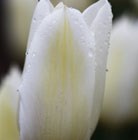New products at Crocus
by Sarah - August 12th, 2010.Filed under: Crocus, New Products.
New products added today at Crocus
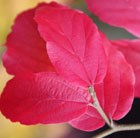
Persian ironwood £21.99
Position: full sun or partial shadeSoil: moist, well-drained soil, preferably acidicRate of growth: fast-growingFlowering period: January to FebruaryHardiness: fully hardyIn autumn, this deciduous tree is a breathtaking sight, as its large, smooth, wavy-edged leaves turn brilliant yellow, then orange and finally blaze fiery red before falling. In late winter and early spring, insignificant, spidery, red flowers appear before the leaves. Persion ironwood is a spreading tree, with a short trunk and peeling grey and fawn bark. As it normally has multiple stems, it is best grown as a large shrub in the border or in an open woodland garden. It can get very big, so it is best suited to larger gardens.Garden care: Requires minimal pruning. Remove any broken, diseased or crossing branches in late autumn or winter. When planting incorporate lots of well-rotted garden compost in the planting hole and stake firmly.
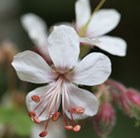
rock cranesbill £6.99
Position: full sun or full shadeSoil: fertile, well-drained soilRate of growth: fast growingFlowering period: May to AugustHardiness: fully hardyClusters of small, saucer shaped, white flowers are held on slender stems above strongly aromatic, light green leaves from May to September. This is one of the most versatile and useful geraniums, as it will thrive even in dry shade. The deeply cut, semi-evergreen foliage also spreads quickly to form low hummocks that suppress weeds for most of the year. It looks lovely with strongly shaped perennials, such as bergenia, or polemonium, or planted en masse under trees, and is also valuable for hiding the foliage of spring bulbs as they die down. The leaves often turn red in the autumn, too.Garden care: Carefully weed by hand – hoeing can break rhizomes as these are very close to the surface. Lift and divide large colonies in spring.
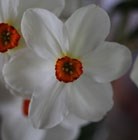
small-cupped daffodil £5.99
Position: full sun or partial shadeSoil: well-drained soilRate of growth: averageFlowering period: March and AprilFlower colour: creamy white perianth with a small orange cupOther features: excellent as cut-flowers; contact with the sap may cause skin irritationHardiness: fully hardyFirst introduced by E.M. Crosfield around 1910, the perianth of this time-honoured species has broad, overlapping, milky white segments, which open out wide and flat, and a small, red-orange cup. These charming flowers appear singly at the top of the stout stems a little later than your average daffodil, so as well as being very attractive, they are useful for extending the season.Garden care: Plant 10-15cm (4-6in) deep from late summer to early autumn. After flowering feed with a balanced fertiliser, dead-head and allow the leaves to die back naturally.
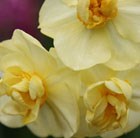
double daffodil £4.99
Position: full sun or partial shadeSoil: well-drained soil Rate of growth: fast-growing Flowering period: March and April Flower colour: golden-yellowOther features: excellent cut-flowers; contact with the sap may cause skin irritationHardiness: fully hardyBulb size: 10/12Stems of up to four fragrant, double, golden-yellow flowers in March and April and narrow, strap-shaped leaves. These double narcissus look great in small drifts in a mixed or shrub border. Planted 10-15cm (4-6in) deep in early autumn they flower best in full sun in fertile, well-drained soil that remains moist during winter and spring.Garden care: Wearing gloves plant bulbs 10-15cm (4-6in) deep from late summer to early autumn. After flowering feed with a balanced fertiliser, dead-head and allow the leaves to die back naturally.

triumph tulip £4.99
Position: full sunSoil: fertile, well-drained soilRate of growth: averageFlowering period: April – MayFlower colour: orange, heavily streaked with bronzeOther features: excellent cut-flowersHardiness: fully hardyBulb Size: 12+Val Bourne spotted this and felt we had to offer it! Cairo is a fairly recent introduction in the tulip world and has been bred for its shimmering, bronze-infused, orange flowers. The classic shaped flowers are scented and appear in April and are great for adding depth to orange planting schemes. Alternatively if you are feeling bold, try mixing it with reds and purples.Garden care: In September to December plant bulbs 15-20cm deep and 10-15cm apart in fertile, well-drained soil. Alternatively, allow 7-9 bulbs per 30cm sq. After flowering dead-head and apply a balanced liquid fertiliser each week for the first month. Once the foliage has died down naturally lift the bulbs and store in a cool greenhouse.







